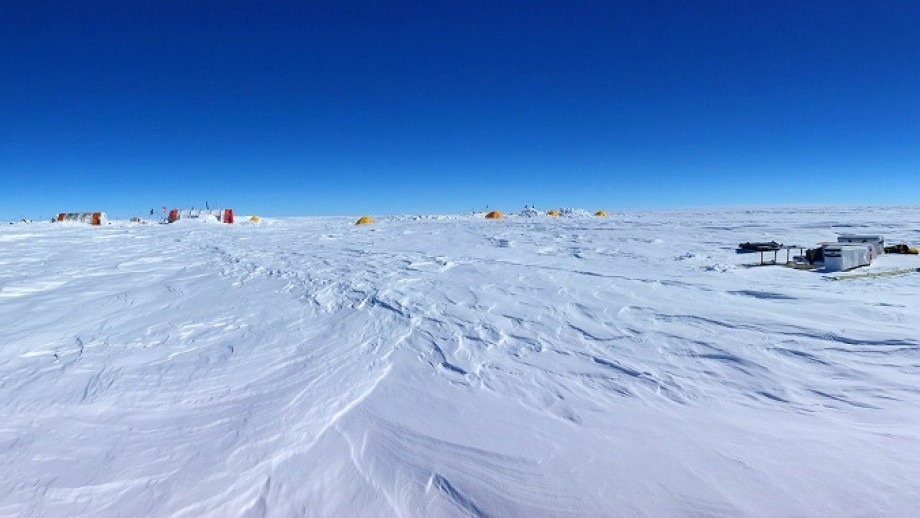If countries throughout the world are successful in fulfilling the climate targets stated in the Paris Agreement, the disastrous impacts of global warming on the greatest ice sheet in the world may be avoided.
 A field camp on the surface of the East Antarctic Ice Sheet, Princess Elizabeth Land. Image Credit: Nerilie Abram/Australian National University.
A field camp on the surface of the East Antarctic Ice Sheet, Princess Elizabeth Land. Image Credit: Nerilie Abram/Australian National University.
An international group of climate scientists, including specialists from The Australian National University (ANU) and the Australian Centre for Excellence in Antarctic Science (ACEAS), have analyzed how much sea levels might rise if the East Antarctic Ice Sheet (EAIS) were to melt as a result of climate change.
According to the team’s findings, the EAIS is expected to result in a sea level rise of less than half a meter by the year 2500 if global temperatures are kept to well below 2 °C above pre-industrial levels. In case the targets are not met, sea-level rise from the EAIS alone could climb up to 5 m in the same time period.
The study was published in the journal Nature.
The research team asserts that the EAIS, which contains the vast majority of Earth’s glacier ice, will probably not contribute to sea-level rise this century if greenhouse gas emissions are significantly reduced and just a slight increase in global warming is observed. However, the researchers assert that irreversible ice loss from West Antarctica or Greenland will cause sea levels to continue rising.
The investigators warn that if countries did not meet the Paris Climate Agreement targets, they would risk awakening a “sleeping giant.”
The EAIS is 10 times larger than West Antarctica and contains the equivalent of 52 m of sea level. If temperatures rise above 2 °C beyond 2100, sustained by high greenhouse gas emissions, then East Antarctica alone could contribute around 1 to 3 m to rising sea levels by 2300 and around 2 to 5 m by 2500.
Nerilie Abram, Study Co-Author and Professor, Research School of Earth Sciences, Australian National University
The window of opportunity to protect the largest ice sheet on Earth from the effects of climate change, according to Professor Abram, is rapidly disappearing.
A key lesson from the past is that the EAIS is highly sensitive to even relatively modest warming scenarios. It isn't as stable and protected as we once thought. Achieving and strengthening our commitments to the Paris Agreement would not only protect the world's largest ice sheet, but also slow the melting of other major ice sheets such as Greenland and West Antarctica, which are more vulnerable to global warming.
Nerilie Abram, Study Co-Author and Professor, Research School of Earth Sciences, Australian National University
The University of New South Wales (UNSW) co-author Professor Matthew England said the expected increase in sea level rise from the EAIS would add to rising sea levels brought on by ocean thermal expansion and melting of ice elsewhere.
Already, satellite observations show signs of thinning ice and its retreat. Our models show that the rate of ocean warming will only increase dramatically if we don't reduce greenhouse gas emissions.
Matthew England, Study Co-author and Professor, University of New South Wales
The University of Tasmania’s (UTas) Professor Matt King, a study co-author, said the findings show how much more research is needed to understand more about East Antarctica.
“We understand the Moon better than East Antarctica. So, we don't yet fully understand the climate risks that will emerge from this area,” Professor King states.
To determine the impact of varying levels of future greenhouse gas emissions on the ice sheet by the years 2100, 2300 and 2500, the researchers looked at how the EAIS responded to warm periods in Earth’s past and examined projections produced by previous studies.
The latest research from the Intergovernmental Panel on Climate Change (IPCC), which was released last year, states that since pre-industrial times, human activity has already elevated the average global temperature by around 1.1 °C.
By keeping global warming far below 2 °C, according to Professor Abram, it is possible to avert the worst-case scenarios of global warming and even avert significant losses from the EAIS.
Professor Abram adds, “We used to think East Antarctica was much less vulnerable to climate change, compared to the ice sheets in West Antarctica or Greenland, but we now know there are some areas of East Antarctica that are already showing signs of ice loss. This means the fate of the world's largest ice sheet very much remains in our hands.”
The study was headed by Durham University in the United Kingdom and is a collaboration between scientists from Australia, France, the United States and the United Kingdom.
Journal Reference:
Stokes, C. R., et al. (2022) Response of the East Antarctic Ice Sheet to past and future climate change. Nature. doi.org/10.1038/s41586-022-04946-0.